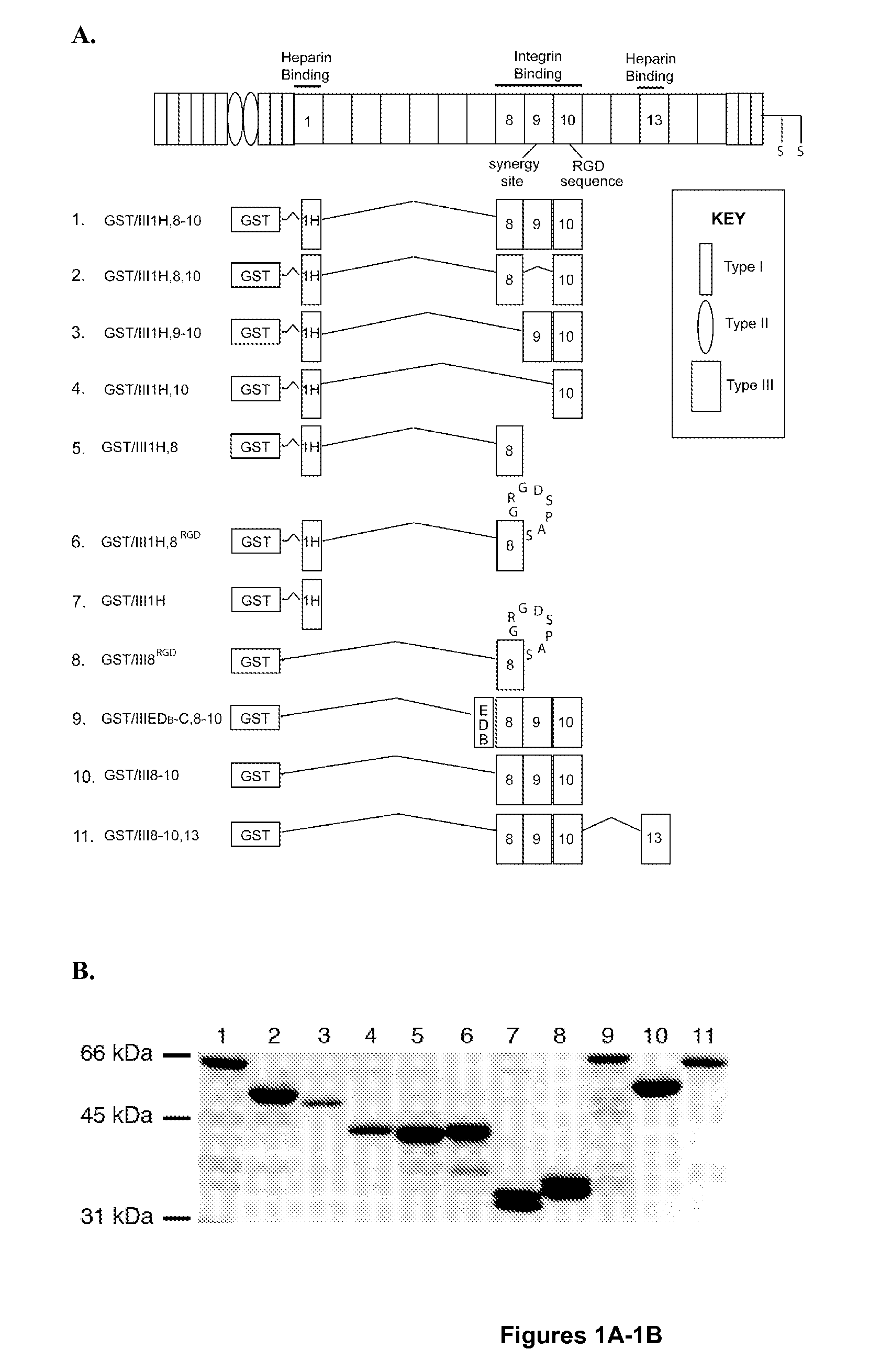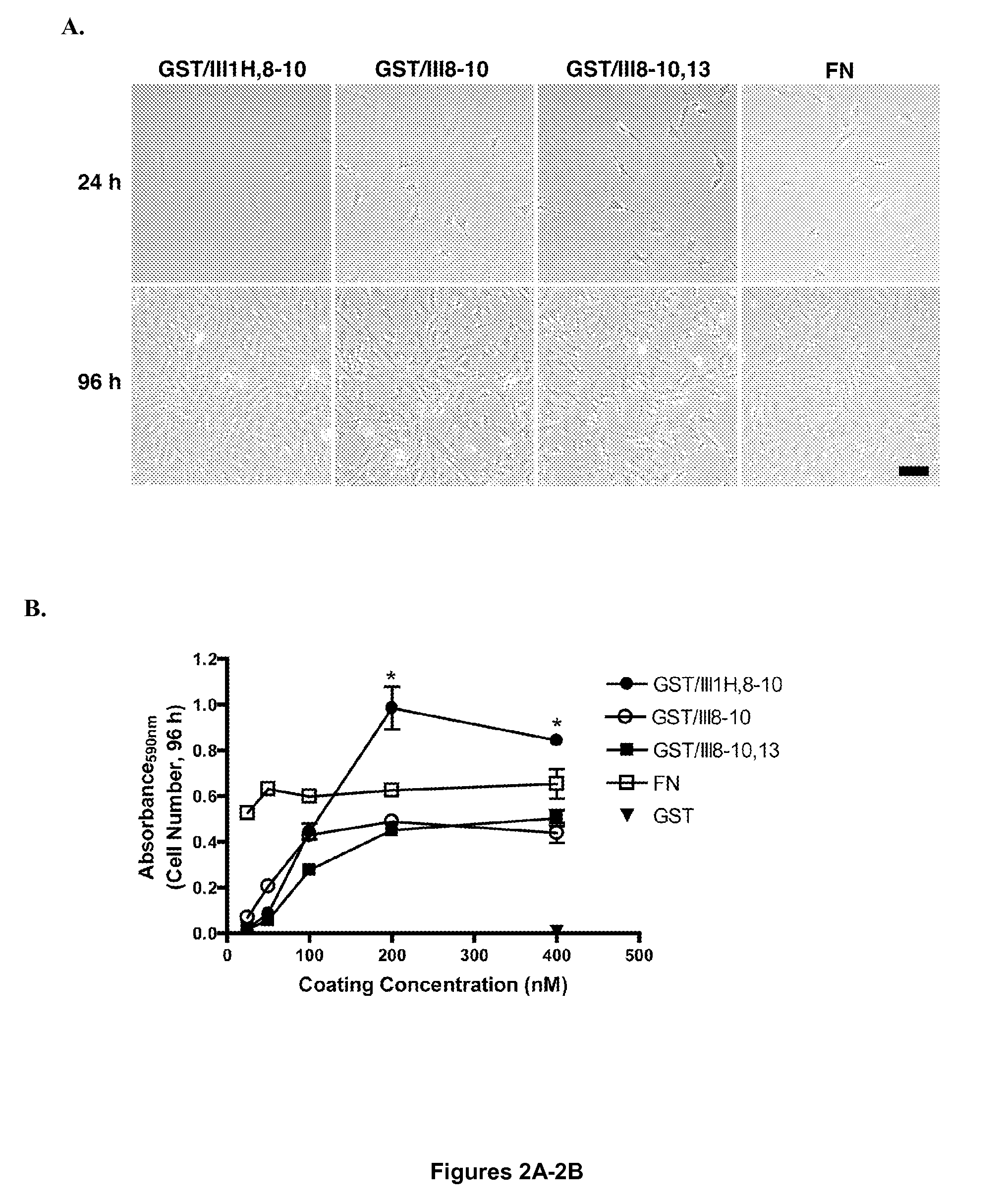Chimeric fibronectin matrix mimetics and uses therof
a technology of chimeric fibronectin and mimetics, which is applied in the direction of peptide/protein ingredients, peptide sources, applications, etc., can solve the problems that none of these compositions augment the function of extracellular matrix fibronectin, and achieve rapid stimulation of cell spreading, migration and growth, and enhance cell and tissue function , the effect of enhancing the function of the extracellular matrix
- Summary
- Abstract
- Description
- Claims
- Application Information
AI Technical Summary
Benefits of technology
Problems solved by technology
Method used
Image
Examples
example 1
GST / II1H,8-10 Supports Cell Adhesion and Spreading, and Enhances Cell Proliferation
[0114]A recombinant fibronectin construct (GST / III1H,8-10) was previously developed that mimics many of the cellular effects of ECM fibronectin, by directly coupling the cryptic, heparin-binding fragment of the first type III repeat of fibronectin to the integrin-binding domain (Hocking et al., “A Cryptic Fragment From Fibronectin's III-1 Module Localizes To Lipid Rafts And Stimulates Cell Growth And Contractility,”J. Cell Biol. 158:175-184 (2002), which is hereby incorporated by reference in its entirety). Addition of soluble GST / III1H,8-10 to the culture media of adherent FN-null MEFs enhances cell spreading, growth, and contractility (Hocking et al., “A Cryptic Fragment From Fibronectin's III-1 Module Localizes To Lipid Rafts And Stimulates Cell Growth And Contractility,”J. Cell Biol. 158:175-184 (2002), which is hereby incorporated by reference in its entirety), increases the migration rate of sma...
example 2
The Heparin-Binding Site in FNIII1H is Essential but not Sufficient for Increased Cell Growth
[0117]To further evaluate the role of FNIII1H in the proliferative response to GST / III1H,8-10, a fusion protein was produced in which the analogous C-terminal region of the ED-B module of fibronectin was substituted for FNIII1H (GST / IIIEDB-C,8-10) (Peptide #9, FIG. 1A). FN-null MEFs were seeded onto surfaces coated with 200 nM GST / III1H,8-10, GST / IIIEDB-C,8-10, GST / III8-10, or GST / III1H and cell number was determined after 96 h. Similar to results shown in FIG. 2B, surfaces coated with GST / III1H,8-10 produced a significant increase in cell number versus surfaces coated with either GST / III8-10 or GST / IIIEDB-C,8-10 (FIG. 4A). No difference in initial cell adhesion to surfaces coated with GST / III1H,8-10, GST / III8-10, or GST / IIIEDB-C,8-10 were observed (FIG. 4B). Surfaces coated with GST / III1H alone did not support either cell adhesion (FIG. 4B) or proliferation (FIG. 4A).
[0118]The growth-promot...
example 3
FNIII8 and FNIII10 are Required for the Cell Growth Response
[0119]FNIII8, FNIII9, and FNIII10 form the primary integrin-binding region of fibronectin, regulating cell adhesion and cell surface receptor specificity (Magnusson et al., “Fibronectin: Structure, Assembly, and Cardiovascular Implications,”Arterio. Thromb. Vasc. Biol. 18:1363-1370 (1998), which is hereby incorporated by reference in its entirety). FNIII10 contains the integrin-binding, RGD sequence (Pierschbacher et al., “Variants of the Cell Recognition Site of Fibronectin that Retain Attachment-Promoting Activity,”Proc. Natl. Acad. Sci. U.S.A. 81:5985-5988 (1984), which is hereby incorporated by reference in its entirety), whereas FNIII9 contains a sequence, termed the synergy site, which promotes binding to α5β1 integrins (Aota et al., “The Short Amino Acid Sequence Pro-His-Ser-Arg-Asn in Human Fibronectin Enhances Cell-Adhesive Function,”J. Biol. Chem. 269(40):24756-24761 (1994), which is hereby incorporated by referen...
PUM
| Property | Measurement | Unit |
|---|---|---|
| density | aaaaa | aaaaa |
| thickness | aaaaa | aaaaa |
| width | aaaaa | aaaaa |
Abstract
Description
Claims
Application Information
 Login to View More
Login to View More - R&D
- Intellectual Property
- Life Sciences
- Materials
- Tech Scout
- Unparalleled Data Quality
- Higher Quality Content
- 60% Fewer Hallucinations
Browse by: Latest US Patents, China's latest patents, Technical Efficacy Thesaurus, Application Domain, Technology Topic, Popular Technical Reports.
© 2025 PatSnap. All rights reserved.Legal|Privacy policy|Modern Slavery Act Transparency Statement|Sitemap|About US| Contact US: help@patsnap.com



